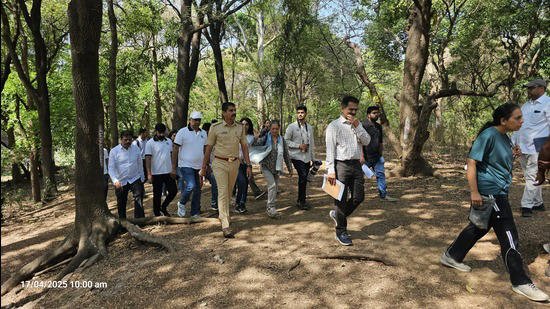The Pune Municipal Corporation (PMC) and the Forest Department recently conducted a joint visit to Devrai, a sacred forest located at the confluence of the Ram Nadi and Mula River. This visit was aimed at assessing the ecological health of the region and discussing potential conservation measures to safeguard its unique environment.
The Devrai area is not only an important ecological zone, but it also holds significant cultural and religious value for the local communities. The confluence of the Ram Nadi and Mula River, where the sacred forest is situated, has become a site of interest for both environmentalists and residents alike. The joint visit was initiated in response to concerns raised about the ongoing threats to the region’s biodiversity, including encroachments, deforestation, and the degradation of natural resources.
A Sacred Forest with Ecological Importance
Devrai, which translates to “sacred grove” in Marathi, is one of the last remaining patches of indigenous forest in the region. These forests have long been a part of the local cultural traditions, with many communities considering them sacred. They are home to a wide variety of flora and fauna, some of which are unique to the area and are essential for maintaining the ecological balance of the region.
Located at the confluence of the Ram Nadi and Mula River, Devrai is a key part of the larger ecosystem that sustains Pune’s water resources. The convergence of the two rivers provides the forest with rich groundwater supplies, which helps maintain its lush greenery and diverse plant and animal life. The area also serves as a natural buffer zone, protecting the surrounding urban areas from flooding during the monsoon season.
Despite its ecological importance, Devrai has faced increasing pressures over the years. Urbanization, illegal encroachments, and deforestation have slowly eroded its natural habitat. The joint visit by PMC and the Forest Department was seen as a proactive step to assess the current condition of the forest and devise a strategy to protect it for future generations.
Joint Effort for Conservation
The joint visit involved officials from both the Pune Municipal Corporation and the Maharashtra Forest Department, including environmental experts, forest officers, and local authorities. During the visit, the team conducted a thorough inspection of the forest area, taking stock of its health and identifying potential threats to its biodiversity. The team also interacted with local communities to understand their perspectives on the conservation of the region and the importance of preserving Devrai.
One of the key issues discussed during the visit was the encroachment of the forest area by illegal settlers. Many of these encroachments have resulted in the loss of valuable forest cover, which has had a detrimental impact on the local ecosystem. The officials also observed instances of illegal logging, which is threatening the sustainability of the forest and the many species that depend on it.
Another pressing concern was the pollution of the Ram Nadi and Mula River, which has affected the quality of water flowing through the area. The rivers, which are vital for the survival of the Devrai forest, have been subject to increased industrial waste and untreated sewage, further endangering the delicate balance of the ecosystem.
Key Steps for Future Conservation
Following the inspection, the officials from PMC and the Forest Department laid out a framework for the future protection and conservation of Devrai. One of the major steps will involve strengthening the legal framework to prevent encroachments and protect the forest from further degradation. The authorities are also looking at improving patrol mechanisms and surveillance to ensure that illegal activities such as logging and encroachments are swiftly addressed.
Additionally, the Forest Department has recommended that the area be declared a conservation zone, which will grant it special legal protections and ensure that its biodiversity is preserved. The focus will be on rehabilitating the degraded portions of the forest, replanting native species of plants, and removing invasive species that threaten the ecosystem.
Another key measure discussed was the importance of restoring the water quality of the Ram Nadi and Mula River. The officials are working on plans to curb the pollution in these rivers by ensuring better wastewater management and stricter enforcement of environmental regulations for industries in the surrounding areas.
Collaboration with Local Communities
A crucial aspect of the conservation plan is the active involvement of local communities. The residents who live near the Devrai area have long had a connection with the forest, and their knowledge of the local environment can be instrumental in conservation efforts. The authorities plan to work closely with these communities to raise awareness about the importance of protecting the forest and rivers, as well as providing them with alternative livelihood options that do not harm the environment.
The joint effort between PMC, the Forest Department, and local communities aims to create a sustainable model of coexistence between urban development and environmental preservation. By involving the public and stakeholders in the decision-making process, the authorities hope to ensure that the conservation efforts are not only effective but also long-lasting.
The joint visit to Devrai at the Ram Nadi-Mula River confluence marks an important step in the preservation of one of Pune’s most valuable ecological assets. The efforts of the Pune Municipal Corporation and the Forest Department reflect a growing recognition of the need to balance urbanization with environmental protection. By addressing threats like encroachments, pollution, and deforestation, and by working with local communities, the authorities hope to ensure that Devrai continues to thrive as a sacred grove and a vital part of the region’s natural heritage.
As the project moves forward, it serves as an example of how joint collaboration between government agencies, local communities, and environmentalists can help protect the biodiversity and ecological health of critical areas. Through such efforts, Pune can secure a future where nature and development can coexist harmoniously, benefiting both the environment and the people.

